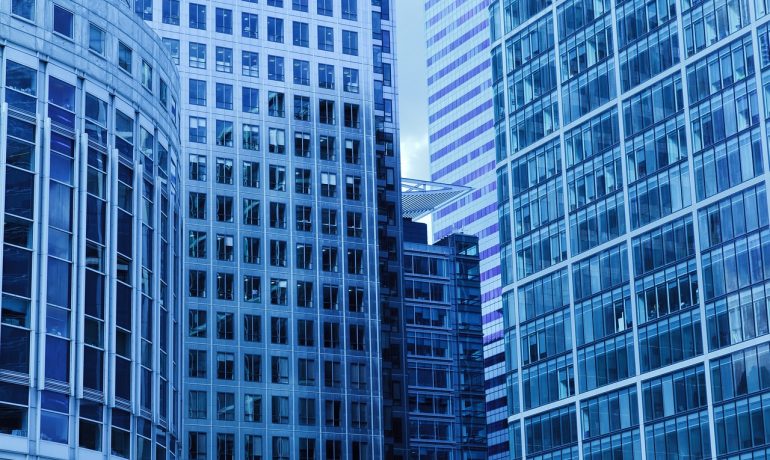The growth of hybrid working following the pandemic led to many suggestions of a fundamental and permanent shift in the demand for offices and their design. Given the long lead times on building new offices – often beyond economic cycles – this clearly is an important area of foresight. A recent “weak signal” – HSBCannouncing a planned move from Canary Wharf back to St Paul’s – suggests it is time to look again at this issue. After all, HSBC was the iconic lead in the original movement to Canary Wharf.
HSBC is not alone in looking at reconfiguring their office space. BP is re-locating its headquarters from St James Square to Carlton House Terrace, near Trafalgar Square, reducing its floor-space by 30%. It is also moving its main trading operations within Canary Wharf. According to a Knight Frank survey, half of the largest businesses – those with more than 50,000 employees – expect to shrink their global workspaces On the other hand of 640 corporate real estate professionals globally 55% were expecting their floorspace to increase in the next 3 years.
The survey also showed that more than half of those surveyed favoured a hybrid working model, with 30% favouring an “office first” model.
McKinsey’s analysis suggests that hybrid working has led to office attendance stabilising at 30% below pre-pandemic norms, and demand for office and retail space in “superstar cities” (including London) falling by 13%. However, there is a push-back against hybrid working from some conservative companies and managers, so quite how this plays out remains uncertain.
Experiments with four-day working have been largely positive. In a recent trial, of the 61 companies that participated, 56 are continuing with the four-day week (92%), with 18 confirming the policy is a permanent change. However, it is notable that there is not a “one-size fits all” solution, with several models being trialled. The knock-on effects on the wider city eco-system as footfall falls in hospitality and retail could be significant as well.
One theme emerging is that of “high quality” office space. The City of London Corporation tenants are seeking a new quality of space: buildings with ‘best-in-class’ sustainability credentials, provision of meeting spaces, good access to amenities, as well as quality design which communicates the company’s brand and values.
Suburbs are likely to benefit from hybrid working as well. Larger homes and green spaces attract middle-class office workers while apartment developments with shared facilities could woo more junior staff.
But most commentators are just looking at the 3 to 5 year horizon, when the lead-time of major building projects is up to 10 years, and the lifetime of the building many decades. So it is important that developers (like other industries) consider the longer term drivers of change.
One approach is resilience, in the sense of a re-purposable “neutral-use” building whose design, infrastructure, and technology could be easily modified to serve different uses. For example an office block that could easily converted into a medical building, hotel or an apartment building. Modular, modern prefabricated units could be the way forward to achieve this.
That fits with another theme emerging from the long-term trend of building for NetZero – modify rather than demolish and re-build. The concept of “embedded carbon” will increasingly come into development equations. The Secretary of State has refused Marks and Spencer permission to demolish its flagship Oxford Street store. Michael Gove refused permission partly because it would “fail to support the transition to a low carbon future, and would overall fail to encourage the reuse of existing resources, including the conversion of existing buildings”.
Other climate change factors will include design for hotter summers, with a minimum of air-conditioning, more consideration of flooding risks and storms more generally. New materials such as low-carbon concrete and steel produced in hydrogen furnaces will increasingly change designs. Urban green space will be much in demand.
The ageing population is another consideration. Older workforces with several generations of workers bring workplace design challenges, and may demand different, again more flexible, facilities.
Geo-political uncertainty may not yet be a major factor in the design of UK buildings, but those in the east of Europe will increasingly be required to have shelters and bunkers as part of their design. Helsinki reputedly has enough shelters for all of its population.
As well as technology developments in building materials, the technology requirements of office workers will change dramatically, requiring ever more advanced, and upgradeable infrastructure. The Internet of Thingswith so many more sensors supported by advanced decision software will automate the control of energy, water and other factors within buildings.
And then there is the imponderable about the effect of AI on the workforce. BT said the introduction of AI across its business could result in the elimination of the equivalent of about 10,000 roles. On the other hand, many analysts believe AI will also create a whole range of new jobs. What is clear, however, is that these will be different, with different requirements than today’s massive call-centres.
And finally we come back to how changing social attitudes – to work, to colleagues, the environment – will shape the design of buildings.
Perhaps more than many other industries, the office construction sector needs to be building plans that can adapt to changing needs, with contingency plans ready to go.
Written by Huw Williams, SAMI Principal
The views expressed are those of the author(s) and not necessarily of SAMI Consulting.
Achieve more by understanding what the future may bring. We bring skills developed over thirty years of international and national projects to create actionable, transformative strategy. Futures, foresight and scenario planning to make robust decisions in uncertain times. Find out more at www.samiconsulting.co.uk.
If you enjoyed this blog from SAMI Consulting, the home of scenario planning, please sign up for our monthly newsletter at newreader@samiconsulting.co.uk and/or browse our website at https://www.samiconsulting.co.uk
Featured image by PublicDomainPictures from Pixabay


